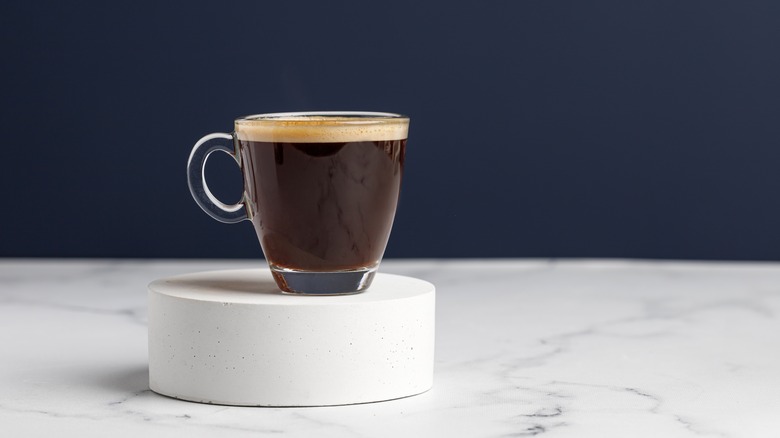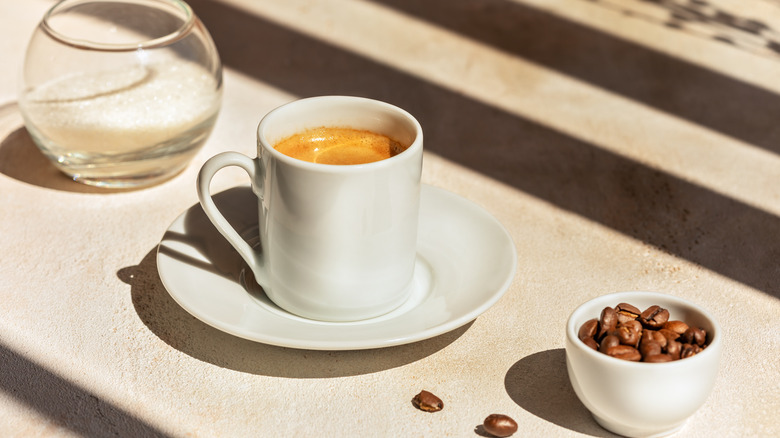The Difference Between Australian Short And Long Black Coffees
Ordering coffee in Australia is a thing. You want simple, black coffee? Your best bet is a short black, which is essentially one shot of espresso. Your other option is a long black, which is espresso poured into hot water. That's not the only distinction between the two, but it's a good place to start.
If you walk up to a barista in a cafe and ask for a short or long black coffee, you're still doing it wrong, according to the coffee cheat sheet on Australia's tourism website. Instead, start by telling the cashier if you plan to stay in the cafe or if you are ordering your drink to take away. Next, mention if you prefer a paper cup and what size you want (regular or large are usually the only choices).
After that comes your actual coffee order, but if you are looking for a version of drip-brewed coffee found in other countries, you are out of luck — espresso is the Australian way. Travel writer Alina Polishuk wrote about her coffee-ordering experience for Afar magazine, which began with feelings of embarrassment as she was thrown off by the stilted, unfamiliar coffee conduct. Thankfully, her journey led her to experience what Australia's deeply rooted coffee ethos is meant to embody: camaraderie, friendship, time to connect, and a really, really good cup of espresso.
What's notable about a short black coffee?
A short black coffee is the cornerstone from which all Australian coffees commence. If you've heard of the ubiquitous Australian flat white, it starts with a shot of espresso. Basically, everything on the Australian coffee menu begins with an espresso shot (or two) and is elaborated on from there.
A typical short black is 1 ounce of espresso (a standard shot), according to Australian coffeehouse Black Market Coffee. The beans are high quality and freshly roasted and ground, since older beans deliver less crema (that frothy layer). An espresso shot is brewed at a ratio of one to two of coffee to water, so that the extracted grounds produce a perfectly punchy, intense flavor after 15 to 30 seconds (or shorter if you are going for a restricted, or ristretto short black), according to the brew ratio and espresso guide, Flair Espresso. Australian baristas are skilled at dialing into the perfect point where the weight of the espresso extraction and the resulting drink is well-balanced and produces the best taste, aroma, and overall experience on the tongue.
A short black is served straight up with no milk. It may appear to have a bit of foam due to the pressure of extraction on the coffee bean oils, which results in a thin layer of creamy-looking bubbles. A short black is served in a demitasse cup, which is often pre-heated, depending on the cafe.
How is a long black coffee different?
A long black coffee, like a short black, is served straight up with no milk. Its core components are two shots of espresso (2 ounces) and hot water. The trick is in its preparation. To make a traditional long black coffee, pour hot water into a mug, then pour two shots of espresso over top. The bitterness and intensity of the coffee are diluted by the boiling water. Major elements of the espresso experience, like its aromatic notes and rich frothy crema, are still intact. The idea is to give the flavors room to expand in the extra water, which differs from the dense hit of a short black.
A long black coffee is regularly compared to an Americano, which also consists of two shots of espresso and hot water. However, its preparation is the exact opposite; the espresso is added first, then hot water is poured over the top. There's no crema at the top like a long black, instead, a thin layer develops in the middle of the drink.
According to former World Barista Champion and trending coffee influencer James Hoffmann, the long black is a "stronger, slightly more textured drink," due to its cultural origins in Australia and New Zealand. Compare that to the lore that World War II American soldiers needed a watered-down espresso, causing Italian baristas to oblige with the Americano.


